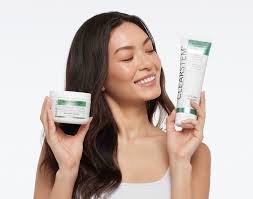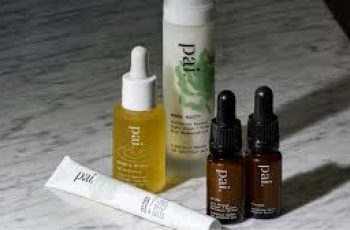
Comedogenic Ingredients and Acne-Causing Ingredient Checker
Looking for information on comedogenic ingredients? Our up-to-date pore clogging ingredient checker has a list of the most common ingredients that cause clogged pores and acne.
You can find the complete list in alphabetical order at the end of this blog.
Comedogenic ingredients are the terrible for acne-prone skin When pores are clogged, comedones (clusters of oil, dirt, and bacteria) can form on the skin.
If you have oily, acne prone skin or commonly get clogged pores, avoid these ingredients in skin care products.
To find out if your skin type and determine if you need to avoid comedogenic ingredients, take the our skin type questionnaire!
What Are The Most Common Comedogenic Ingredients?
While there are many pore clogging ingredients, some are more popular in skincare than others. Whether an ingredient is popular or not, if it is comedogenic, it is still the worst for acne prone skin
Some especially common ingredients known to be comedogenic are: (1-5)
1. Beeswax:
Beeswax is a popular ingredient in all kinds of skincare and makeup products, such as foundations and concealers, but it can clog the pores and cause breakouts. Beeswax is a thick ingredient that does not allow keratin to leave pores, allowing oil, dirt and grime to sit under the skin and cause breakouts.
Interestingly, honey and some other bee products are comedogenic.
Check out this blog on honey to get the facts on its use in skin care.
2. Cocoa Butter
While cocoa butter may feel great on dry skin, it’s more than likely clogging the pores on your face; an indicator of its comedogenicity is how thick and creamy it feels.
Cocoa butter fills the pores and prevents oxygen from circulating.
If you use liquid/melted cocoa butter as a makeup remover, be sure to follow up immediately after with a cleanser to get it out of your pores.
3. Dimethicone
Dimethicone is a silicone-based polymer found in many oily skin products including sunscreen. It can cause comedones, especially if you do not wash your face with a cleanser at night. Not all forms of dimethicone cause comedones, so products many vary.
4. Isopropyl Myristate, Isopropyl Isostearate, Myristyl Lactate
These compounds are used in many products and are well known causes of comedones. Acne medications such as in tretinoin, Retin A, and and Winlevy contain these ingredients. Yes, acne medications! Yikes! Instances like these are exactly why understanding ingredient science is so important in designing a custom skin care regimen.
Skin care brands are allowed to call products acne treatments even if they clog pores, because they might be antibacterial or anti-inflammatory. These three ingredients in particular are easy to overlook on a label because of their esoteric names. Be sure to avoid them if you have acne prone skin.
5. Coconut Oil
Coconut oil is commonly found in “DIY” skincare recipes, but it often clogs the pores for acne-prone individuals.
What is interesting is that a compound within coconut oil called lauric acid is actually used to treat acne; that is to say, some extracts of coconut oil are not comedogenic. For example, the skincare brand VMV Hypoallergenics uses a form of coconut oil that does not cause acne.
It can be confusing by just reading the label – but keep in mind that extracts are less likely to be comedogenic than unrefined or even many refined coconut oils.
6. Red Pigment
Some cosmetic colors found in blushes and lip sticks can cause comedones. Red colors are the most common problematic color in cosmetics.
Specifically, red dies made with xanthenes, monoazoanilines, fluorans, and indigoids are comedogenic. (14)
A complete alphabetical list of comedogenic ingredients in cosmeceuticals is at the end of this blog
Comedogenic vs. Non-Comedogenic
Comedogenic means “a product or ingredient that results in clogged pores” Clogged pores are also called open or closed comedones.
These are clogged hair follicles that contain a build up of keratin and debris. When the closed comedones are very deep they are called milia.
If you are acne- prone or have oily skin, comedogenic ingredients can increase the number of breakouts you experience.
Non-comedogenic means any product or ingredient that doesn’t result in comedones, milia, blocked pores or acne.
It’s essential to be aware of what ingredients cause these pink or white bumps on the skin so you can be on the lookout for specific ingredients when you’re shopping for skincare products.
Whether or not a cosmetic ingredient causes comedones depends upon factors such as:
Baumann Skin Type
Order of products in skin care routine
Sun exposure (some ingredients become comedogenic when exposed to ultraviolet light)
Combination with other ingredients and skin care products. For example Ceteareth- 20 and Cetearyl Alcohol are not acne causing when found alone in skin care products but when they are combined together they become comedogenic.
How natural ingredients are processed. Some pure forms of coconut oil are safe while less pure forms are comedogenic.
Comedogenic ingredients that cause acne
How Do We Know if Skincare Ingredients Are Comedogenic?
The first dermatologist to study comedogenic skincare products was Dr. Albert Kligman. He developed a rabbit ear model to assess which cosmetic ingredients are comedogenic. The ingredient is placed inside the rabbit ear, and then the ear is evaluated for the presence of blackheads.
In 1984, dermatologist Dr. Jim Fulton did a large study to see which cosmeceutical ingredients caused blackheads when applied to a rabbit’s ear. The data from Fulton’s study is usually found on lists of comedogenic ingredients. Other similar studies have been done on the comedogenicity of skincare products using the rabbit ear model.
These studies have resulted in a very long comedogenic ingredients list. Once animal testing fell out of favor, there was less comedogenicity testing until 1982, when Kligman described a human model to evaluate purported comedogenic products.
From these studies, we can determine that skincare ingredients are comedogenic if they cause breakouts, even if they don’t occur every time they’re used.
how to know if an ingredient is comedogenic
Comedogenicity rating system
A rating system now exists that rates ingredients on a scale of zero to five. A rating of zero means that the product is non-comedogenic and won’t cause a breakout. A rating of five means that the product has the highest chance of clogging your pores.
Kligman scale is 0-3 with 3 being the most comedogenic The scale isn’t always accurate since there are other factors that contribute to comedogenesis, but it is an excellent pore clogging ingredient checker.
The other common rating system is the Fulton 0-5 scale. Here is a chart of pore clogging ingredients tested in a rabbit ear model.
Note, this is not the full list; the full list is further below.
Table of comedogenicity ratings of various skin care ingredients
Non-Comedogenic Ingredient Examples
Many people believe natural ingredients are all non-comedogenic, but this is not always the case. Ingredients such as beeswax and wheat germ oil are natural but can clog the pores. Many also believe all oils clog the skin, and while many do, some help you fight off the bacteria that causes acne.
A few of the non-comedogenic ingredients you can use include:
Salicylic acid: Much like sulfur, salicylic acid stops excess oil production by drying the skin and eliminating dead skin cells that clog the pores.
Hemp seed oil: While many oils do cause breakouts, not all oils are comedogenic, and some oils can actually prevent acne. Hemp seed oil is one of these oils, and it works by preventing dryness, which can force the skin to produce more oil and result in breakouts. Hemp seed oil also doesn’t clog the pores as other oils do.
Argan Oil- This oil is not comedogenic and has anti-inflammatory ingredients.
Lauric acid- coconut oil extract.
Why Is There Disagreement on Which Skincare Product Ingredients Cause Blackheads and Comedones?
If you take the time to read all of the studies on skincare ingredients and their ability to clog pores, you will see differences in the studies about which ingredients cause blackheads. There are several reasons for this:
Species variations: The rabbit model does not always correlate with what is seen in humans.
Location variations: In human testing, where the ingredient was placed on the skin affected testing results. In other words, an ingredient may cause breakouts on one area, such as the forehead, and not in other areas, such as the chin. The site chosen in testing may affect whether or not the ingredient causes breakouts.
Ingredient base: The ingredient’s base can affect the testing. For example, an alcohol base versus an oil base changes how the ingredient reacts with the skin.
Application method: How roughly the ingredient is applied and the direction can affect entry into the hair follicle, which is the site of clogged pores.
Ingredient quality: Pure ingredients will react differently than ingredients that have other substances in them.
Ingredient mixtures: Mixing the ingredient with other ingredients will change the characteristics of the comedogenic ingredient. Finished products using comedogenic ingredients do not always cause blackheads because of this.
Additional products: Using the ingredient in combination with other skincare products can change the ability of the ingredient to cause a breakout. This is why it is important to consider every skincare product in the skincare routine and how it affects other products.
Some ingredints must be exposed to sun before they are comedogenic
Can a Skincare Ingredient Clog Pores Sometimes but Not Other Times?
Whether or not a skincare ingredient is comedogenic is determined by the skin type of the individual using it. In other words, the skin changes frequently, and different skin conditions will affect whether or not an ingredient will clog the skin.
Here are some of the factors that can play a role in whether a cosmetic ingredient is comedogenic:
Humidity
Temperature
pH
UV light
Hormone status
Stress
Over exfoliation
Cleanser type
Skin microbiome
Pollution
Reactions with other ingredients
As you see, there is much variability in which cosmeceutical ingredients cause blackheads. A list of the most common comedogenic culprits follows. However, you should pay close attention to which ingredients bother your skin. If you are on the best skincare routine for your Baumann Skin Type®, you should not be experiencing breakouts.
Take the Quiz
Does Ceteareth-20 cause acne?
Ceteareth -20 is on interesting skin care ingredient because:
Found in Cera Ve and many popular products
It does not cause acne when used alone
It does cause acne when combined with cetearyl alcohol
You should not use ceteareth-20 and cetearyl together
Which ingredients become comedogenic in the sun?
These ingredients become more comedogenic with sun exposure:
human sebum
sulphur
cocoa butter
squalene
coal tar
Note that human sebum can cause acne and clogged pores when exposed to sun. So wash your face immediately after exercising in the sun.
What skin care brand is noncomedogenic?
Comedogenic Ingredient Checklist in Alphabetical Order
Having a handy list of comedogenic ingredients can help you prevent future breakouts and skin irritation. This is not a comprehensive list, but below are some common ingredients that can cause acne breakouts and blackheads, listed in alphabetical order. Look for these ingredients in each skincare product you use, especially if you are trying to treat frequent acne breakouts, and check their rating on the comedogenic scale before using them on your skin.
A
Acetylated Lanolin Alcohol
Algin
Almond Oil
Anhydrous Lanolin
Arachidic Acid
Ascorbyl Palmitate
Avobenzone
Azulene
B
Beeswax
Benzaldehyde
Benzoic Acid
Beta Carotene
BHA
Bubussa Oil
Butyl Stearate
Butylated Hydroxyanisole (BHA)
C
Cajeput Oil
Calendula
Camphor
Capric Acid
Carbomer 940
Carnuba Wax
Carotene
Carrageenan
Castor Oil
Ceteareth- 20 (read below about this ingredient)
Cetearyl Alcohol
Cetyl Acetate
Cetyl Alcohol
Chaulmoogra Oil
Cocoa Butter
Coconut Butter
Coconut Oil
Colloidal Sulfur
Collagen
Corn Oil
Cotton Seed Oil
D
D & C Red Pigments
Decyl Oleate
Dioctyl Succinate
Disodium Monooleamido
E
Emulsifying Wax NF
Ethoxylated Lanolin
Ethylhexyl Palmitate
Evening Primrose Oil
F
Fluorans
G
Glyceryl-3-Diisostearate
H
Hexadecyl Alcohol
Hyaluronic acid (some molecule weights)
Hydrogenated Castor Oil
Hydrogenated Vegetable Oil
Hydroxypropylcellulose
I
Indigoids
Isocetyl Alcohol
Isodecyl Oleate
Isopropyl Isosterate
Isopropyl Lanolate
Isopropyl Linoleate
Isopropyl Myristate
Isopropyl Neopentanoate
Isopropyl Palmitate
Isostearyl Isostearate
Isostearyl Neopentanoate
L
Laneth 10
Lanolin Acid
Lanolin Alcohol
Lanolin Oil
Lanolin Wax
Laureth 4 and 23
M
Menthyl Anthranilate
Methoxycinnamate
Mink Oil
Monoazoanoline
Myristic Acid
Myristyl Lactate
O
Octyl Palmitate
Octyl Stearate
Oleth-10
Oleth-3
Oleyl Alcohol
Oxybenzone
P
Palmitic Acid
Peach Kernel Oil
Peanut Oil
PEG 100 Distearate
PEG 150 Distearate
PEG 16 Lanolin
PEG 200 Dilaurate
PEG 2-Sulfosuccinate
PEG 8 Stearate
Pentaerythritol Tetra Isostearate
PG Caprylate/Caprate
PG Dicaprylate/Caprate
PG Dipelargonate
PG Monostearate
Polyethylene Glycol (PEG 400)
Polyethylene Glycol 300
Polyglyceryl-3-Diisostearate
Potassium Chloride
PPG 2 Myristyl Propionate
PPG-5-Ceteth-10 Phosphate
Propylene Glycol Monostearate
Pumpkin Seed Oil
R
Red Algae
S
Sandalwood Seed Oil
Sesame Oil
Shark Liver Oil
Solulan 1
Solulan 16
Sorbitan Oleate
Soybean Oil
Steareth 10
Steareth 2
Steareth 20
Stearyl Heptanoate
Sulfated Castor Oil
Sulfated Jojoba Oil
Synthetic Dyes, (D&C Red #S 3, 4, 6, 7, 9, 17, 19, 21, 27, 230, 33, 36, 40)
T
Triethanolamine
V
Vitamin A Palmitate
W
Wheat Germ Glyceride/Oil
Xanthenes
Xylene
List of Comedogenic Oils
These oils are slightly comedogenic:
Sweet Almond Oil
Flax seed Oil
Linseed Oil
These oils are comedogenic:
Evening Primrose Oil
Hydrogenated Castor Oil
Mink Oil
Peach Kernel Oil
Peanut Oil
Pumpkin Seed Oil
Sandalwood Seed Oil
Sesame Oil
Shark Liver Oil
Soybean Oil
Sulfated Castor Oil
Sulfated Jojoba Oil
Wheat Germ Glyceride/Oil
To let us help you build a noncomedogenic skin care routine, take the quiz.


